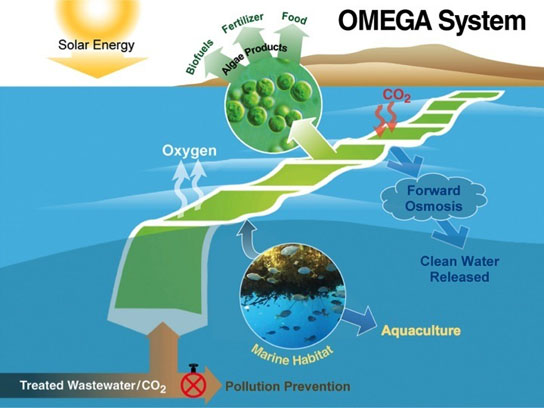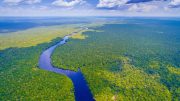
Offshore Membrane Enclosures for Growing Algae (OMEGA) is a pioneering approach for algae cultivation, wastewater purification, carbon dioxide capture, and biofuel production, without encroaching on agricultural resources such as water, fertilizer, or land.
In an effort to create an alternative way to produce aviation fuels, NASA is exploring the Offshore Membrane Enclosures for Growing Algae method for biofuel. The OMEGA system is an environmentally friendly way to produce biofuel that uses wastewater and could lead to the reduced the release of greenhouse gases and decreased ocean acidification.
Offshore Membrane Enclosures for Growing Algae (OMEGA) is an innovative method to grow algae, clean wastewater, capture carbon dioxide and to ultimately produce biofuel without competing with agriculture for water, fertilizer, or land.
NASA’s OMEGA system consists of large flexible plastic tubes, called photobioreactors. Floating in seawater, the photobioreactors contain freshwater algae growing in wastewater. These algae are among the fastest-growing plants on Earth.
The algae use energy from the sun, carbon dioxide, and nutrients from the wastewater to produce biomass that can be converted into biofuels as well as other useful products such as fertilizer and animal food. The algae clean the wastewater by removing nutrients that otherwise would contribute to marine deadzone formation.
NASA’s project goals are to investigate the technical feasibility of a unique floating algae cultivation system and prepare the way for commercial applications. Research by scientists and engineers has demonstrated that OMEGA is an effective way to grow microalgae and treat wastewater on a small scale.
The OMEGA system is being investigated by NASA as an alternative way to produce aviation fuels. Potential implications of replacing fossil fuels include reducing the release of greenhouse gases, decreasing ocean acidification, and enhancing national security.

Wastewater with oil-producing algae circulate through photobioreactors (green tubes) floating in a seawater tank at the San Francisco Southeast Wastewater Treatment Plant, where NASA has set up one of its OMEGA research facilities. Credit: NASA
OMEGA Project Objectives:
NASA’s project goals are to investigate the technical feasibility of a unique floating algae cultivation system and prepare the way for commercial applications. Research by scientists and engineers has demonstrated that OMEGA is an effective way to grow microalgae and treat wastewater on a small scale.
Algae do not currently contribute significantly to biofuel production because of logistical and economic issues. Large-scale algae farms (millions of acres) will require huge pipelines for wastewater and CO2, the farm infrastructure, and a transportation network for the diverse products. On land, neither the required energy nor the economic returns on investment can be met. It is not known if OMEGA, using existing offshore wastewater outfalls, coastal CO2 sources, ships, and local energy sources can meet the required returns. At this stage OMEGA warrants further investigations.
The next step is for other organizations to deploy larger-scale systems offshore in protected bays to determine if OMEGA can be used commercially for biofuels production, environmental remediation, wastewater treatment or carbon sequestration.
The detailed results of the investigations will be published in scientific journals and made publicly available in the near future. The next step is for others to deploy larger-scale systems in protected bays to determine if OMEGA can be used commercially for biofuels production, environmental remediation, wastewater treatment, and carbon sequestration.
OMEGA Project Accomplishments:
(NASA OMEGA project: Jan 2010 – May 2012)
- Demonstrated controlled microalgae growth on wastewater in floating PBRs.
- Operated 100, 200, 1,600, and 3,200-liter PBR systems for repeated algal growth cycles.
- Showed that forward osmosis could be potentially coupled with OMEGA to enhance both biomass production and wastewater treatment.
- Showed efficient uptake of CO2 using gas exchange column.
- Developed protocols for harvesting algae and controlling grazers.
- Determined impact of biofouling.









Be the first to comment on "NASA Explores OMEGA System for Alternative Aviation Fuels"